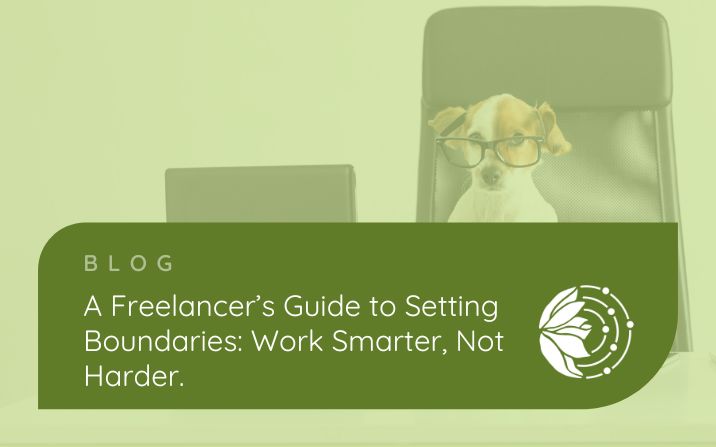A Freelancer’s Guide to Setting Boundaries: Work Smarter, Not Harder
As a freelancer, striking the right balance between being accommodating and standing your ground can be challenging but setting boundaries with your clients is essential for your business to be successful.
In this blog post, I’ll be discussing why you should be putting boundaries in place and how to go about it, so you can have the work-life balance you want without compromising on your success as a small business owner.
Why is it important to set boundaries as a business owner or freelancer?
Protecting your personal time is important when you’re self-employed. As an employee, you have established working hours, typically 9 – 5, where you’d show up, do the work, and then go home again without having to think about work again until the next working day.
When you’re a freelancer, set working hours are gone and it can be tempting to work much longer hours for fear of dry spells. If you don’t do the work as it comes in then you’ll end up turning down work, right?
What’s much more likely to happen is that you’ll work far too much, skimp on your self-care and family time, and end up with business owner burnout making you unable to work for months at a time due to chronic fatigue, depression, and difficulty concentrating (amongst other symptoms).
The other side of the coin is that many of our clients are also small business owners or freelancers who also work all the hours they can – so we end up receiving emails, WhatsApp, and Facebook messages on weekends or even late at night. We then feel compelled to reply straight away and maybe even hop on to the laptop for a quick five minutes (that turns into an hour or more).
Putting boundaries in place with your clients about when and how you work, how they should contact you and other expectations helps you to protect your personal time and your health, so you have the energy and drive to make your business a success.
So, here are my top 3 tips for putting boundaries in place with your clients
1 – Decide on your working hours (and stick to them!)
Just because you can work more than a 37-hour week, doesn’t mean that you should be! Many of us went self-employed so we’d have more time at home to spend with our family, or because we needed flexibility around other commitments.
As the boss, you can decide how many hours you want to work a week and when those hours are. You might be a night owl and prefer working late into the evening or an early bird and like to get started with the dawn chorus. If you’re completely flexible try setting a ‘no work past 6pm’ or similar deadline for yourself to ensure you have some free time to relax and unwind at the end of the day.
When you work is completely up to you – I tend to work longer hours during term time when my girls are in school and shorter hours during the school holidays so I can spend more time with them (and enjoy some of those holidays myself!)
The important thing here is that you set boundaries with yourself first. Stick to your working hours and don’t be tempted to do an extra half an hour here or there – spend that time on yourself, or your family instead.
2 – Define your communication preferences
Just because your client messages you at 11pm at night doesn’t mean you have to reply at that time. Unfortunately, some clients do seem to expect us to be working around the clock but their expectations don’t have to become your reality. Clearly inform your clients about your response time (e.g., within 24 hours) to avoid any miscommunications and prevent clients from expecting instant replies.
I have core hours in place where clients know that I am working and am easily contactable, any emails or messages received outside of my core hours aren’t answered until the next day/core hours. I communicate these hours during the onboarding process with new clients and I have it as part of my email signature as a quick reminder too.
I also highlight how I prefer to be contacted by my clients. I know some freelancers make themselves available on Microsoft Teams during their core hours so their clients can quickly message them and hop on a call if needed. Other business owners prefer email-only contact with pre-agreed meetings to discuss how things are going, etc.
Again, it’s important that you decide on what’s best for you and stick to it. If you don’t want WhatsApp or Facebook messages that’s ok – make it clear to your clients how they should contact you instead. Clear communication is vital for successful working relationships with your clients.
I personally don’t receive any work emails on my phone and I disable notifications when I’m not working. By doing it this way, I’m protecting my time and setting expectations with my clients. You should be doing the same thing.
3 – Saying no isn’t a bad thing as a business owner
You want to deliver fantastic customer service. You think that by going above and beyond you’ll make your clients really happy, they’ll recommend you to everyone and you’ll get more clients as a result.
And yes, that is true but it should never come at a cost to yourself. If you don’t want to say no to something a client asks of you because you’re scared it’ll upset them, or it’ll cost you more work but by doing it you’re having to work more hours than you want, or having to turn down other work…
It’s ok to say no.
People pleasing doesn’t make for a successful business and unfortunately, there are some clients who will try to take advantage of your good nature. ‘Scope creep’ can happen quite quickly when your client asks for ‘just one more thing’ and you don’t say no and suddenly they’re adding more and more to your workload.
If I’m asked to do something that falls outside of the scope of work agreed in my contract, I will probably say ‘yes but it will be charged at my usual hourly rate’, or ‘no, I’m not able to do that at this time. Can I recommend someone who can?’
When I started my business and talked to other small business owners and freelancers about the best way to work with clients, I was told that my way of working wouldn’t lead to a successful business. Well, I’m still here, 9 years later and my business has surpassed my own expectations!
You decide what’s best for you and your business. Just remember that whatever you decide, put firm boundaries in place, communicate them clearly to your clients, and stick to them! Sometimes, saying no is the best way to ensure your continued success.

